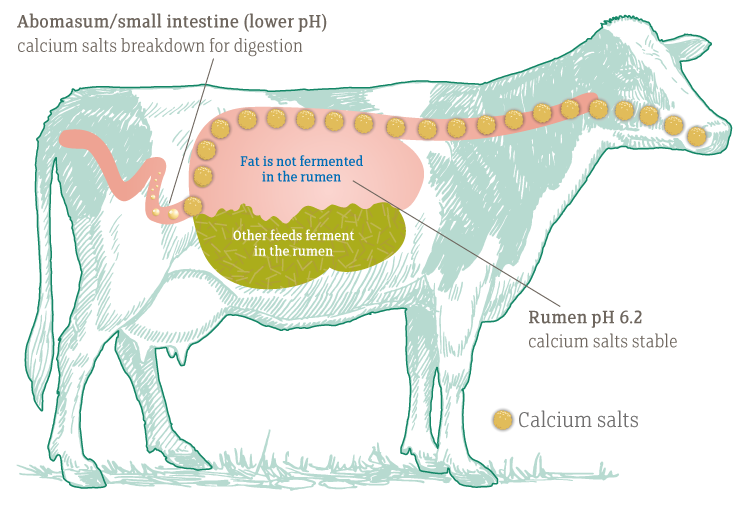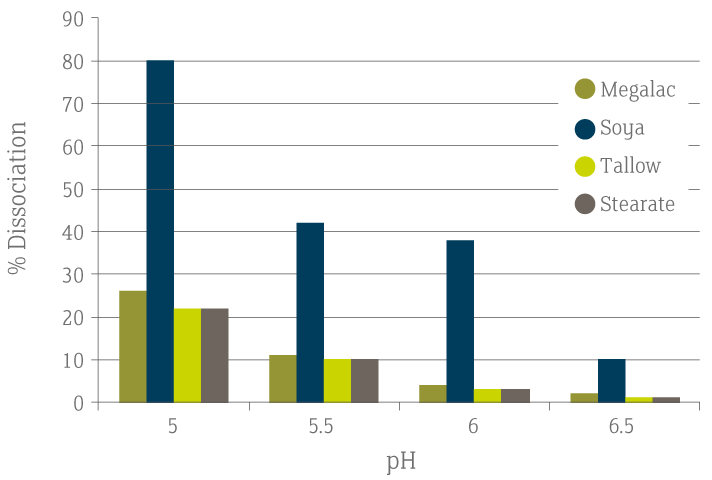Rumen-protected fats - calcium salt supplements
Calcium salts can be manufactured from any fatty acids but the most common are based on palm fatty acids (normally palm fatty acid distillate; PFAD). These supplements are produced by reacting fatty acids with calcium to produce a solid, rumen-insoluble fat source which passes largely unchanged through the rumen to the small intestine for digestion avoiding negative effects on fibre digestion. Calcium salts of palm oil are typically stable at the high pH values found in a ‘healthy’ rumen (pH above 6.0), but break down (dissociate) in the acid conditions of the abomasum (fourth stomach) (pH 2.5). Both the fat and calcium components are then available for absorption by the animal (Figure 1).
 Figure 1 Stability and breakdown of calcium salts in the animal
Figure 1 Stability and breakdown of calcium salts in the animal
However, not all calcium salts are the same and both physical characteristics and type of fatty acids used in their manufacture can have a major effect on their stability and function :
- Products with larger granules are more stable and provide improved rumen protection compared with those composed of finer particles.
- The blend of fatty acids present will influence the animal’s response to the supplement – different fatty acids can exert different effects in the animal.
- Individual fatty acids differ in their degree of rumen stability as calcium salts – more-unsaturated fatty acids will dissociate at higher rumen pH. Research undertaken with calcium salts of PFAD (Megalac) has reported rumen stability of 90% even at pH as low as 5.5 (Sukhija and Palmquist, 1990), while those of more-unsaturated soya fatty acids have considerably lower stability across the typical pH ranges in the rumen (Figure 2).
 Figure 2 Dissociation of calcium salts of different fatty acids
Figure 2 Dissociation of calcium salts of different fatty acids
Volac Wilmar’s Megalac is the original calcium salt product (manufactured from PFAD) and was developed in conjunction with Prof. Don Palmquist at Ohio State University in the USA and Dr Eric Miller from the University of Cambridge in the UK.
Megalac rumen-protected fat has been proven on-farm and independent research studies for over 30 years, with proven benefits including improved milk yield and cow fertility. Research in the USA has demonstrated an average response of 2.3 kg milk/cow/day to an approx. 500 g/d supplement of Megalac, while further studies indicate improved fertility through increased conception rates and reduced days open.
Digestibility of calcium salts is expected to be high (average 96% from a selection of studies with Megalac reported in the literature), likely reflecting their content of unsaturated fatty acids, in particular oleic acid. Furthermore, the post-ruminal delivery of oleic acid (C18:1), a known amphiphile, to the small intestine can also act to improve digestion of total fat in the ration, leading to improved feed efficiency and increased energy available from the diet. The high digestibility and efficiency of use of the metabolisable energy (ME) from calcium salts contributes to the high net energy (NEL) value recorded for the Megalac product; 27.3 MJ/kg dry matter measured in vivo with lactating dairy cows (Andrew et al., 1991).
In addition to increased milk production, improved fertility is a key target with calcium salt supplementation, with potential mechanisms including improved energy status, increased progesterone production and improved viability of ovulated eggs.
Click here to find more detail about Volac Wilmar’s Megalac product
Click here for details of research studies with Megalac